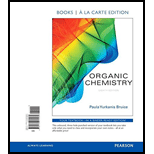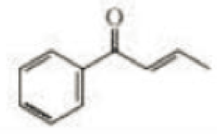
Organic Chemistry, Books a la Carte Edition (8th Edition)
8th Edition
ISBN: 9780134074580
Author: Bruice, Paula Yurkanis
Publisher: PEARSON
expand_more
expand_more
format_list_bulleted
Concept explainers
Textbook Question
Chapter 17, Problem 5P
Describe three ways to synthesize the following compound:

Expert Solution & Answer
Want to see the full answer?
Check out a sample textbook solution
Students have asked these similar questions
pls help
Indicate the product of the reaction
OH OH
CH3-CC- Ph + H2SO4 a 20°C
|
CH3 Ph
pls help
Chapter 17 Solutions
Organic Chemistry, Books a la Carte Edition (8th Edition)
Ch. 17.1 - Prob. 1PCh. 17.1 - Prob. 2PCh. 17.1 - Prob. 3PCh. 17.1 - Prob. 4PCh. 17.1 - Rank the compounds in each of the following groups...Ch. 17.2 - Explain why 92% of 2,4-pemtanedione exists as the...Ch. 17.3 - Draw the enol tautomers for each of the following...Ch. 17.3 - Prob. 8PCh. 17.4 - Prob. 9PCh. 17.4 - Prob. 10P
Ch. 17.5 - Show how the following compounds can be prepared...Ch. 17.6 - What compound is formed when a dilute solution of...Ch. 17.7 - Prob. 13PCh. 17.7 - Prob. 14PCh. 17.7 - How many stereoisomers are obtained from each of...Ch. 17.7 - Prob. 16PCh. 17.8 - Prob. 17PCh. 17.9 - Prob. 18PCh. 17.9 - What reagents should be used to prepare the...Ch. 17.10 - Prob. 20PCh. 17.10 - What aldehyde or ketone would be obtained when...Ch. 17.11 - Prob. 22PCh. 17.11 - How could you prepare the following compound using...Ch. 17.12 - Prob. 25PCh. 17.12 - What two carbonyl compound are required for the...Ch. 17.12 - Propose a mechanism for the following reaction:Ch. 17.13 - Draw the products of the following reactions:Ch. 17.13 - Prob. 29PCh. 17.13 - Prob. 30PCh. 17.14 - Prob. 31PCh. 17.15 - Write the mechanism for the reaction of a...Ch. 17.15 - Prob. 33PCh. 17.15 - Prob. 34PCh. 17.15 - Draw the product of the reaction of each of the...Ch. 17.16 - Draw the product obtained by heating each pair of...Ch. 17.16 - What two carbonyl compounds are needed to...Ch. 17.17 - Prob. 38PCh. 17.18 - Prob. 39PCh. 17.18 - Prob. 40PCh. 17.19 - Prob. 41PCh. 17.20 - Prob. 43PCh. 17.21 - Propose a mechanism for the formation of...Ch. 17.21 - Prob. 45PCh. 17.21 - a. If the biosynthesis of palmitic acid were...Ch. 17.21 - Prob. 47PCh. 17 - Prob. 48PCh. 17 - Prob. 49PCh. 17 - Number the following compounds in order of...Ch. 17 - The 1H NMR chemical shifts of nitromethane,...Ch. 17 - Prob. 52PCh. 17 - Draw the products of the following reactions: a....Ch. 17 - A racemic mixture of 2-methyl-1-phenyl-1-butanone...Ch. 17 - Draw the products of the following reaction:Ch. 17 - Prob. 56PCh. 17 - Prob. 57PCh. 17 - In the presence of excess base and excess halogen,...Ch. 17 - Identify A-L. (Hint: A shows three singles in its...Ch. 17 - Using cyclopentanone as the reactant, show the...Ch. 17 - Show how 4-methyl-3-hexanol can be synthesized...Ch. 17 - Show how the following compound can be synthesized...Ch. 17 - Show how the following compounds can be prepared...Ch. 17 - Prob. 64PCh. 17 - Prob. 65PCh. 17 - Indicate how each of the following compounds can...Ch. 17 - Prob. 67PCh. 17 - The ketone whose 1H NMR spectrum is shown here was...Ch. 17 - Indicate how the following compounds can be...Ch. 17 - Compound A with molecular formula C6H10 has two...Ch. 17 - Prob. 71PCh. 17 - Draw the products of the following reactions:Ch. 17 - Prob. 73PCh. 17 - a. Show how the amino acid alanine can be...Ch. 17 - Show how the following compounds can be...Ch. 17 - Prob. 76PCh. 17 - Explain why the following bromoketone forms...Ch. 17 - Prob. 78PCh. 17 - A carboxylic arid is formed when an -haloketone...Ch. 17 - An , -unsaturated carbonyl compound can be...Ch. 17 - What carbonyl compounds are required to prepare a...Ch. 17 - Prob. 82PCh. 17 - A Cannizzaro reaction is the reaction of an...Ch. 17 - Propose a mechanism for each of the following...Ch. 17 - The following reaction is known as the benzoni...Ch. 17 - Prob. 86PCh. 17 - Prob. 87PCh. 17 - Prob. 88PCh. 17 - Prob. 89PCh. 17 - Prob. 90PCh. 17 - Propose a mechanism for the following reaction:Ch. 17 - What reagents are required to convert the reactant...Ch. 17 - Starting with bromocyclohexane, how can each of...Ch. 17 - Describe how the following compounds can be...Ch. 17 - Prob. 4PCh. 17 - Describe three ways to synthesize the following...Ch. 17 - Explain why 92% of 2.4-pentanedione exists as the...Ch. 17 - Describe how the following compound can be...Ch. 17 - Prob. 8PCh. 17 - Prob. 9PCh. 17 - Prob. 10PCh. 17 - Show how the following compounds can be...
Knowledge Booster
Learn more about
Need a deep-dive on the concept behind this application? Look no further. Learn more about this topic, chemistry and related others by exploring similar questions and additional content below.Similar questions
- pls helparrow_forwardpls helparrow_forward35) Complete the following equation by drawing the line the structure of the products that are formed. Please note that in some cases more than one product is possible. You must draw all possible products to recive full marks! a. ethanol + 2-propanol + H2SO4 → b. OH conc. H2SO4 CH2 H3C CH + K2Cr2O7 C. d. H3C A pressure CH3 + H2 CH Pt catalystarrow_forward
- 21) The rate of reaction depends upon: a. the concentration and nature of reactants b. the temperature of the reaction C. whether or not a catalyst was used d. all of the above 22) A Maxwell-Boltzmann curve shows the distribution of molecular energies in a reaction system. When the temperature in this system is increased, the peak is a. higher and further to the right. b. higher and further to the left. c. lower and further to the right. d. lower and further to the left. 23) Which of the following correctly describes the reaction represented by the reaction below? CaCO3 (s) + energy → CaO (s) + CO2 (g) a. It is exothermic and the potential energy is greater in the reactants than the products. b. c. It is exothermic and the potential energy is greater in the products than the reactants. It is endothermic and the potential energy is greater in the products than the reactants. d. It is endothermic and the potential energy is equal for the products and reactants.arrow_forwardpls helparrow_forward27) Draw the energy level diagram and write the full and shorthand electron configuration for a neutral sulfur atom.arrow_forward
- Indicate whether these compounds are isomers, enantiomers, or tautomers. OCH OCH محمد ممدarrow_forward30) Substance A to E below are listed with several of their properties. The identities of the substances are identified in random order below: Iron, ethane, ethanol, sodium nitrate, graphite First classify each substance as either a polar covalent compound, non-polar covalent compound, ionic compound, metallic solid, or network solid. Write your predictions in the sixth coloumn of the chart, under "type of substance." Then, identify the identity of the substance in the last coloumn. Substance Melting Point Boiling Point Solubility in H₂O Electrical Conductivity Type of Substance Identity of Substance (°C) (°C) as: Solid, Liquids, Solution A -182 -88 Insoluble No/No/- B 1538 2862 Insoluble Yes/Yes/- C 308 380 Soluble Yes/Yes/Yes Ꭰ 3456 Insoluble No/-/- E -114 78 Soluble No/No/Noarrow_forwardpls helparrow_forward
- 28) Explain the process of galvanization. In your description, make sure to explain what metal is usually used for galvanization and why this metal used.arrow_forward29) Complete the following table Molecule H₂O NH3 Lewis Dot Diagram VSEPR Diagram Name of VSEPR Shapearrow_forward12) What is the best name to describe the shape of water molecule? a. Angular b. C. Tetrahedral Octahedral d. Trigonal pyramidal 13) Network solids are distinguished from metallic crystals in that: a. Network solids have charged ions, while metallic crystals do not. b. Network solids are composed of molecules, while metallic crystals only have one type of atom. C. Network solids are composed of non-metals. d. Network solids have much lower boiling points.arrow_forward
arrow_back_ios
SEE MORE QUESTIONS
arrow_forward_ios
Recommended textbooks for you

 Organic ChemistryChemistryISBN:9781305580350Author:William H. Brown, Brent L. Iverson, Eric Anslyn, Christopher S. FootePublisher:Cengage Learning
Organic ChemistryChemistryISBN:9781305580350Author:William H. Brown, Brent L. Iverson, Eric Anslyn, Christopher S. FootePublisher:Cengage Learning


Organic Chemistry
Chemistry
ISBN:9781305580350
Author:William H. Brown, Brent L. Iverson, Eric Anslyn, Christopher S. Foote
Publisher:Cengage Learning
Coenzymes and cofactors; Author: CH15 SWAYAM Prabha IIT Madras;https://www.youtube.com/watch?v=bubY2Nm7hVM;License: Standard YouTube License, CC-BY
Aromaticity and Huckel's Rule; Author: Professor Dave Explains;https://www.youtube.com/watch?v=7-BguH4_WBQ;License: Standard Youtube License